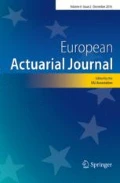Abstract
Solvency II regulation provides different approaches for the calculation of the solvency capital requirement (SCR): standard formula with simplification, standard formula, standard formula with undertaking specific parameters (USP), partial internal model and full internal model. In particular this regulation describes a subset of the Standard Formula market parameters (standard deviations) that may be replaced by USP, in order to calculate the SCR deriving from Premium and Reserving Risks of a Non-Life insurance company. This paper aims to explain the data requirements, methodologies and results according the so-called standardized methods proposed in the Solvency II regulation for the USP. Applying the standardized methods to three companies respectively of small, medium and large sizes and developing some sensitivity analysis, regarding the change in data from year to year, peaks and other issues which standardized methods look sensitive, the paper shows when the USP could reduce the SCR in comparison with the Standard Formula approach.







Similar content being viewed by others
Notes
In R this test is very simple to implement: we could apply the lm function and then we calculate the F-statistics of the significance test with the summary function. If the p value is much less than 0.05, we reject the null hypothesis that β1 = 0 and concluding that there is a significant relationship between the variables in the linear regression model of the data set used. The R function lm is used to fit linear models. It can be used to carry out regression, single stratum analysis of variance and analysis of covariance.
If we use L-BFGS-B method with box constraints rather than BFGS method, we would get almost the same results.
For many others companies analyzed in Cerchiara and Santoni [6] (not shown in this paper) mixing parameter assumes values very close to 1, the superior extreme of the domain.
References
AISAM-ACME (2007) Study on non-life long tail liabilities: reserve risk and risk margin assessment under Solvency II. http://www.amice-eu.org/Download.ashx?ID=12779. Accessed 1 Feb 2016
Appert-Raullin Y, Devineau L, Pichevin H, Tann P (2013) One-year volatility of reserve risk in a multivariate framework. https://hal.archives-ouvertes.fr/hal-00848492v1. Accessed 30 Oct 2015
Bulmer R (2011) Undertaking specific parameters. General Insurance Convention, Liverpool
CEIOPS (2010) Quantitative Impact Study 5—QIS5—Technical Specifications. Brussels. http://ec.europa.eu/internal_market/insurance/docs/solvency/qis5/201007/technical_specifications_en.pdf. Accessed 15 Jan 2016
CEIOPS (2010) CEIOPS’ advice for level 2 implementing measures on solvency II: undertaking specific parameters. https://eiopa.europa.eu/CEIOPS-Archive/Documents/Advices/CEIOPS-L2-Advice-Undertaking-specific-parameters.pdf. Accessed 25 Jan 2016
Cerchiara, RR, Santoni, A (2010) Analisi di Mercato: undertaking specific parameters. ANIA Rome. http://www.ania.it/it/index.html. Accessed 30 Mar 2012
Cerchiara RR, Magatti V (2014) The estimation of standard deviation of premium risk under solvency 2. Math. and Stat. Methods for Actuar. Sci Financ Springer 61–64. ISBN 978-88-470-1481-7
De Felice M, Moriconi F (2015) Sulla stima degli Undertaking Specific Parameters e la verifica delle ipotesi. Working Pap n. 9 of the Dep of Econ, Univ of Perugia (IT). ISSN 2385-2275
Diers D (2009) Stochastic re-reserving in multi-year internal models—an approach based on simulations. ASTIN Colloquium, Helsinki. https://www.actuaries.org.uk/documents/stochastic-re-reserving-multi-year-internal-models-approach-based-simulations. Accessed 18 Jan 2016
EIOPA (2011) Calibration of the premium and reserve risk factors in the standard formula of solvency II, Report of the Joint Working Group on Non-Life and Health NSLT Calibration. https://eiopa.europa.eu/Publications/Reports/EIOPA-11-163-A-Report_JWG_on_NL_and_Health_non-SLT_Calibration.pdf. Accessed 21 Jan 2016
EIOPA (2014) The underlying assumptions in the standard formula for the Solvency Capital Requirement calculation. https://eiopa.europa.eu/Publications/Standards/EIOPA-14-322_Underlying_Assumptions.pdf. Accessed 3 Mar 2016
EIOPA (2014) Technical specifications for the preparatory phase (Part I and II). https://eiopa.europa.eu/regulation-supervision/insurance/solvency-ii/solvency-ii-technical-specifications. Accessed 15 Jan 2016
EIOPA (2015) Guidelines on undertaking-specific parameters. https://eiopa.europa.eu/Publications/Guidelines/USP_Final_document_EN.pdf. Accessed 1 Feb 2016
European Commission (2014) Text of the delegated Act on Solvency II. http://ec.europa.eu/finance/insurance/solvency/solvency2/index_en.htm. Accessed 7 Jan 2016
European Parliament (2009) legislative resolution of 22 April 2009 on the amended proposal for a directive of the European Parliament and of the Council on the taking-up and pursuit of the business of Insurance and Reinsurance
Gisler A (2009) The insurance risk in the SST and in Solvency II: modelling and parameter estimation. ASTIN Colloquium, Helsinki. http://www.actuaries.org/ASTIN/Colloquia/Helsinki/Papers/S3_24_Gisler.pdf. Accessed 16 Dec 2015
Klugman S, Panjer H, Willmot G (2012) Loss models—from data to decisions. Wiley, New York. ISBN 978-1-118-31532-3
Mack T (1993) Distribution-free calculation of the standard error of chain ladder reserve estimates. ASTIN Bull 23(2):213–225
Merz M, Wüthrich MV (2008) Modelling claims development result for solvency purposes. Casualty Actuarial Society, E-Forum Fall. https://www.casact.org/pubs/forum/08fforum/21Merz_Wuethrich.pdf
Merz M, Wüthrich MV (2008) Stochastic claims reserving methods in insurance. Wiley Finance. ISBN: 978-0-470-72346-3
Ohlsson E, Lauzeningks J (2009) The one-year non-life insurance risk. Insur Math Econ 45:203–208
Author information
Authors and Affiliations
Corresponding author
Rights and permissions
About this article
Cite this article
Cerchiara, R.R., Demarco, V. Undertaking specific parameters under solvency II: reduction of capital requirement or not?. Eur. Actuar. J. 6, 351–376 (2016). https://doi.org/10.1007/s13385-016-0139-6
Received:
Accepted:
Published:
Issue Date:
DOI: https://doi.org/10.1007/s13385-016-0139-6




